On 14 April 2023 at 12:14 UTC, ESA's Jupiter Icy Moons Explorer (JUICE - https://www.esa.int/Science_Exploration/Space_Science/Juice) was launched on an 8 years journey to Jupiter. Upon arrival in July 2031, it will study the giant gas planet and its three large ocean-bearing moons Ganymede, Callisto and Europa. Its main objectives are to explore in detail the Jovian system and to examine if habitable worlds around gas giants such a Jupiter are possible. To answer these key-questions, JUICE will carry 10 state-of-the-art instruments which will do remote sensing (from ultraviolet to sub-millimeter), geophysical (altitude, radar, and radio science) and in situ measurements (particle detector, magnetometer, and plasma waves). The Royal Observatory of Belgium (ROB) and the Royal Belgian Institute for Space Aeronomy (BIRA-IASB) are involved in several of these instruments.
The spacecraft will perform a total of 35 fly-bys of the 3 moons in just 3 years: 12 of Ganymede, 21 of Callisto and 2 of Europa (only 2 due to the high radiation exposure). It will then be manoeuvred into an orbit around Ganymede, the largest moon of our solar system (even larger than the planet Mercury!), and the only moon to have a magnetic field of its own (Plainaki et al. 2016). This mini "magnetic bubble" sitting within Jupiter's larger one, interacting with each other in highly complex ways, will then be the focus of study for the remainder of its 4 years mission. When the spacecraft has consumed its remaining propellant, JUICE is planned to be deorbited and impact Ganymede by the end of 2035. In the artist's impression underneath (not to scale), Ganymede is shown in the foreground, Callisto to the far right, and Europa centre-right. Volcanically active moon Io is also shown, at left. The moons were imaged by NASA's Galileo spacecraft; Jupiter is seen here with a vivid aurora, captured by the NASA/ESA Hubble Space Telescope.
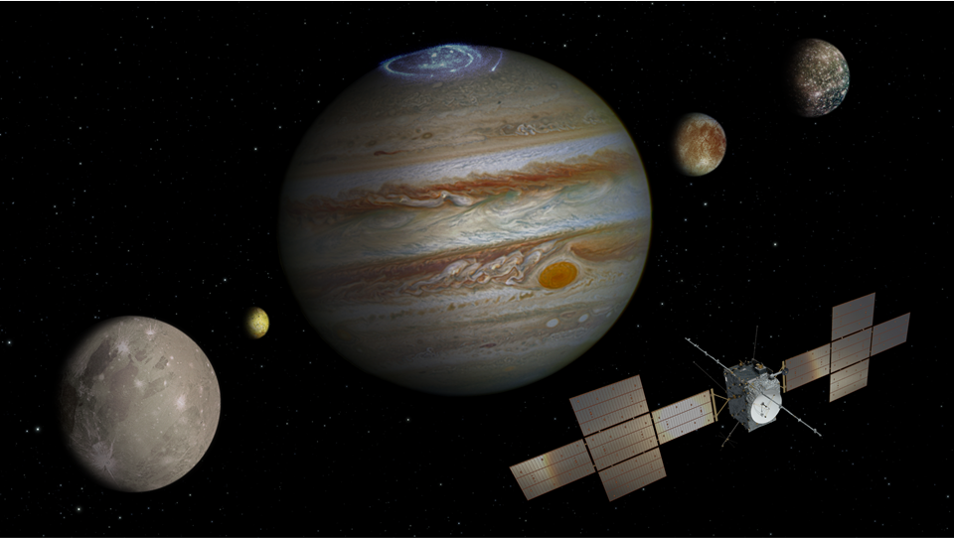
Credits: ESA / ATG medialab / NASA / J. Nichols (University of Leicester) / JPL / University of Arizona / DLR
During the 8 years voyage to the Jovian system, most of JUICE instruments will be dormant. There's however one other instrument and that will be very much awake: RADEM, developed by the Paul Scherrer Institute (Swiss Federal Council). The RADiation–hard Electron Monitor (RADEM) is an instrument specifically designed for ESA's JUICE mission. It will serve as an onboard radiation monitor providing information on particle fluxes and their energy spectra. That's also one of the reasons why JUICE is cruising to Jupiter during the most active phases of the ongoing solar cycle 25 (SC25), i.e. to measure the radiation within the solar system and determine how it relates to solar activity. Between Venus and Jupiter, RADEM will determine the particle spectra and their doses in space and thus map an important parameter for the so-called space weather in this vast region. RADEM should help in our understanding of the related effects from the varying solar activity, and how it influences our planet and future missions, such as a potential manned mission to Mars.
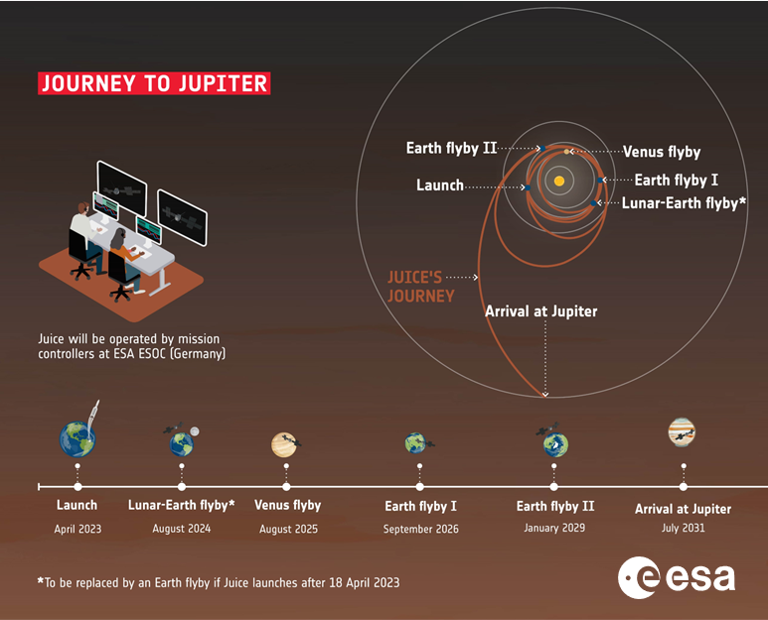
Credits: ESA / JUICE launch kit
Jupiter's magnetosphere is one of the largest structures in our solar system. It is so large that, if it could be somehow visible with the naked eye, it would appear 2 to 3 times as wide as the full moon seen from Earth. Jupiter's equatorial magnetic field is about 18 times stronger than Earth's (417.000 nT vs 25.000 nT). Its magnetopause is located on the average about 3 to 5 million km upstream of Jupiter (Earth: about 60.000 km), whereas -under favorable conditions- its magnetotail can stretch all the way to Saturn's orbit (Weigt et al. 2021)! While Earth's magnetosphere is roughly teardrop-shaped, Jupiter's is flatter, more closely resembling a disk. The main reasons for this disk-like configuration are various forces exerted by the plasma inside the magnetosphere which tend to stretch Jupiter's magnetic field lines, thus forming a flattened pancake-like structure. Another nice feature is that Jupiter's magnetic field is oriented opposite to that of Earth's, with the magnetic field lines exiting the north pole and returning at the south pole. It means that for a solar-wind-induced magnetic storm to occur on Jupiter, the interplanetary magnetic field has to be oriented northward (positive Bz).
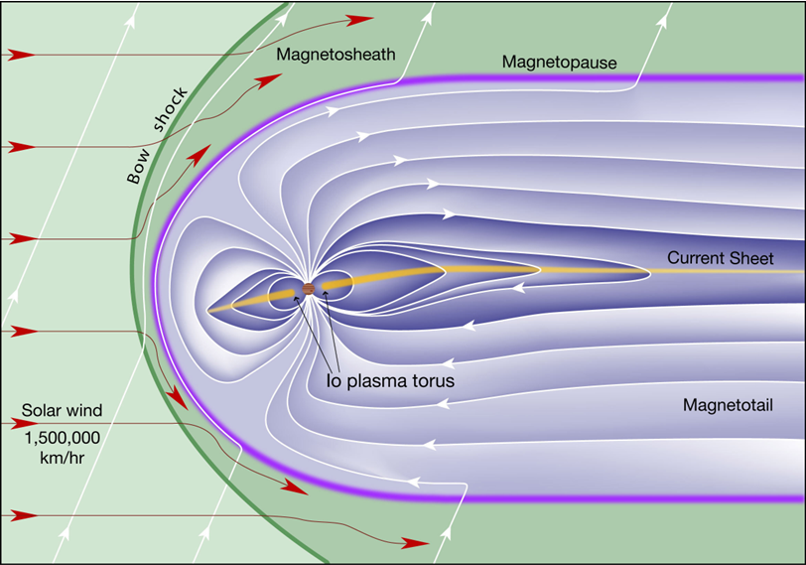
Credits: Fran Bagenal and Steve Bartlett
Jupiter's mammoth magnetosphere also acts as a trap for charged particles. Those particles originate from the solar wind (like on Earth) or are emitted from volcanically active Io and the other Galilean moons. Jupiter's intense magnetic fields, in combination with its very fast rotation (just below 10 hours!) then combine to speed up these particles to extremely high energies, with the highest fluxes of energetic particles found in doughnut-shaped belts around Jupiter's equator (e.g. the "Io torus" - see the ESA imagery (model) underneath). Jupiter's magnetic field is so strong that even ultrarelativistic, 100 GeV protons can be trapped near the planet, over 50 times higher in energy than at Earth (Roussos et al. 2022). Jupiter's inner radiation belts contain electrons with energies in excess of 70 MeV, maybe even up to 100 MeV or about 10 times the energies found in the Earth's outer radiation belt (Khurana et al. 2004). The generated currents such as e.g. the ring current, tail current, field-aligned currents,... typically reach values between 60 and 100 million ampères, whereas the same currents in the Earth's magnetosphere barely reach 1 to 10 million ampères (Keiling et al. 2018). In short: for a satellite this means "Hell"!
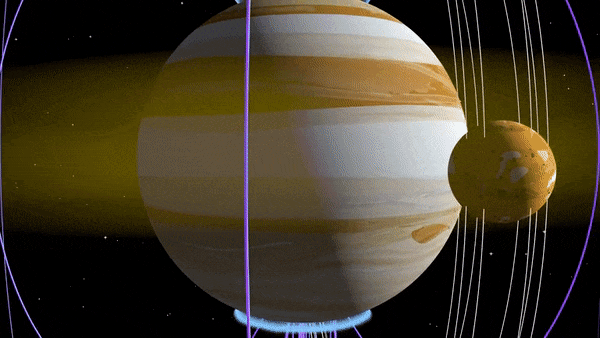
Credits: ESA - Jupiter's radiation belts, and how to survive them...
All those energetic particles constitute a clear and present danger to the satellite and its electronic components. When a charged particle impacts a component, the immediate effect is a "Single Event Upset" (SEU), a brief electrical discharge that might lead to random glitches, memory flips or localised short circuits. Even more significant is the "Total Ionising Dose", which is a gradual degradation of functionality as radiation exposure builds up internal defects within a part. Based on the data from previous Jupiter missions such as Voyager, the Cassini fly-by, and especially Galileo, it has been calculated that JUICE would accumulate in those four years at Jupiter a radiation exposure about the equivalent of a telecommunications satellite in a geostationary Earth orbit for 20 years.
The good news is that satellite engineers do have plenty of experience in managing this kind of hazard. JUICE's most sensitive electronics have been placed inside twin "vaults" within the body of the spacecraft, whose carbon-fibre walls are reinforced with lead. Some parts of the electronics have been developed explicitly for this mission and are highly resistant to radiation. Also, the prolonged stay in this highly charged environment will most likely result in a gradual build up of electrostatic charges across JUICE's surfaces. Though some charging buildup is inevitable, one really wants to avoid differential charging across the spacecraft: as well as disturbing instrument readings these might even in the worst case trigger damaging "electrostatic discharge", resembling space lightning. Accordingly, all the surface layers of the JUICE spacecraft have been designed to be as conductive as possible, to prevent any buildup of charge. Further protection comes from the aforementioned RADEM, which is directly connected to the probe's onboard computer. If the radiation dose exceeds certain limits, the detector triggers an alarm signal. As it is difficult to carry out evasive manoeuvres, particularly sensitive equipment can instead be switched off in such cases, protecting it until the radiation levels are back within the permissible limits.
Good luck valiant JUICE! Night gathers, and now your watch begins.
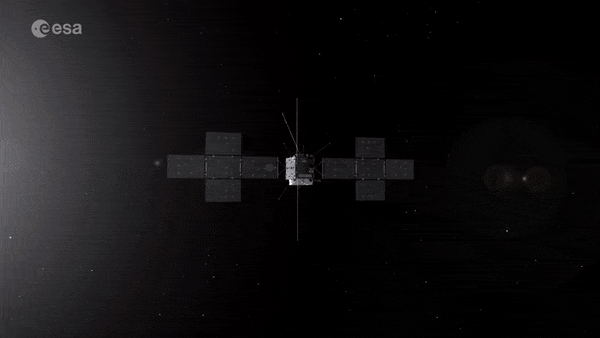
Credits: ESA / ATG medialab





